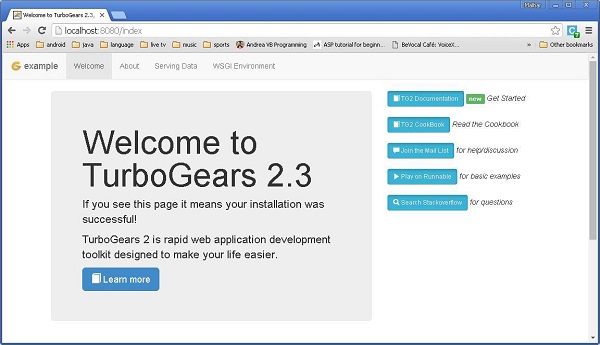
- TurboGears Tutorial
- TurboGears - Home
- TurboGears - Overview
- TurboGears - Environment
- TurboGears - First Program
- TurboGears - Dependencies
- TurboGears - Serving Templates
- TurboGears - HTTP Methods
- Genshi Template Language
- TurboGears - Includes
- TurboGears - JSON Rendering
- TurboGears - URL Hierarchy
- TurboGears - Toscawidgets Forms
- TurboGears - Validation
- TurboGears - Flash Messages
- TurboGears - Cookies and Sessions
- TurboGears - Caching
- TurboGears - Sqlalchemy
- TurboGears - Creating Models
- TurboGears - Crud Operations
- TurboGears - DataGrid
- TurboGears - Pagination
- TurboGears - Admin Access
- Authorization & Authentication
- TurboGears - Using MongoDB
- TurboGears - Scaffolding
- TurboGears - Hooks
- TurboGears - Writing Extensions
- TurboGears - Pluggable Applications
- TurboGears - Restful Applications
- TurboGears - Deployment
- TurboGears Useful Resources
- TurboGears - Quick Guide
- TurboGears - Useful Resources
- TurboGears - Discussion
TurboGears - Dependencies
A TurboGears project contains the following directories −
Config − Where project setup and configuration relies
Controllers − All the project controllers, the logic of web application
i018n − Translation files for the languages supported
Lib − Utility python functions and classes
Model − Database models
Public Static Files − CSS, JavaScript and images
Templates − Templates exposed by our controllers.
Tests − The set of Tests done.
Websetup − Functions to execute at application setup.
How to Install a project
This project now needs to be installed. A setup.py is already provided in project’s base directory. Project dependencies get installed when this script is executed.
Python setup.py develop
By default, following dependencies are installed at the time of project set up −
- Beaker
- Genshi
- zope.sqlalchemy
- sqlalchemy
- alembic
- repoze.who
- tw2.forms
- tgext.admin ≥ 0.6.1
- WebHelpers2
- babel
After installation, start serving the project on development server by issuing following command in shell −
Gearbox serve –reload –debug
Follow the above mentioned command to serve a pre-built example project. Open http://localhost:8080 in browser. This readymade sample application gives a brief introduction about TurboGears framework itself.

In this Hello project, the default controller is created in controllers directory as Hello/hello/controllers.root.py. Let us modify root.py with following code −
from hello.lib.base import BaseController
from tg import expose, flash
class RootController(BaseController):
movie = MovieController()
@expose()
def index(self):
return "<h1>Hello World</h1>"
@expose()
def _default(self, *args, **kw):
return "This page is not ready"
Once a basic working application is ready, more views can be added in the controller class. In the Mycontroller class above, a new method sayHello() is added. The @expose() decorator attaches /sayHello URL to it. This function is designed to accept a name as a parameter from the URL.
After starting server through ‘gearbox serve’ command, http://localhost:8080. Hello World message will be displayed in the browser, even if the following URLs are entered −
http://localhost:8080/
http://localhost:8080/index
All these URLs are mapped to RootController.index() method. This class also has _default() method that will be invoked, whenever a URL is not mapped to any specific function. Response to URL is mapped to a function by @expose() decorator.
It is possible to send a parameter to an exposed function from the URL. The following function reads the name parameter from URL.
@expose() def sayHello(self, name): return '<h3>Hello %s</h3>' %name
The following output will be seen in the browser as response to the URL − http://localhost:8080/?name=MVL
Hello MVL
TurboGears automatically maps URL parameters to function arguments. Our RootController class is inherited from BaseController. This is defined as base.py in the lib folder of application.
Its code is as follow −
from tg import TGController, tmpl_context from tg import request __all__ = ['BaseController'] def __call__(self, environ, context): tmpl_context.identity = request.identity return TGController.__call__(self, environ, context)
TGController.__call__ dispatches to the Controller method the request is routed to.